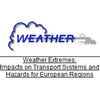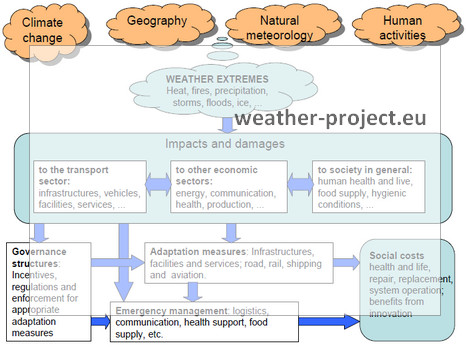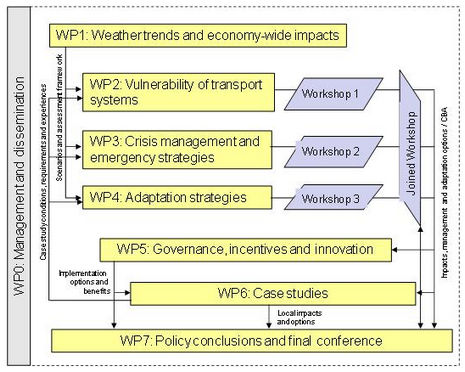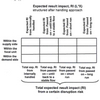 Weather Extremes: Assessment of Impacts on Transport Systems and Hazards for European Regions. That is the formal title of the WEATHER project, a project that is funded through the 7th framework program of the European Union and undertaken by a consortium of 8 partner institutions, lead by the Fraunhofer-Institute for Systems and Innovation Research (ISI) in Karlsruhe, Germany. The WEATHER project aims at analysing the economic costs of more frequent and more extreme weather events on transport and on the wider economy and explores adaptation strategies for reducing them in the context of sustainable policy design. The project has been running since 2009 and perhaps it is now time to look at some of their deliverables and what has been delivered so far?
Weather Extremes: Assessment of Impacts on Transport Systems and Hazards for European Regions. That is the formal title of the WEATHER project, a project that is funded through the 7th framework program of the European Union and undertaken by a consortium of 8 partner institutions, lead by the Fraunhofer-Institute for Systems and Innovation Research (ISI) in Karlsruhe, Germany. The WEATHER project aims at analysing the economic costs of more frequent and more extreme weather events on transport and on the wider economy and explores adaptation strategies for reducing them in the context of sustainable policy design. The project has been running since 2009 and perhaps it is now time to look at some of their deliverables and what has been delivered so far?
Extreme weather and transportation
The impact of a changing climate on transportation is not a topic that appears too often on this blog, and it’s been a while since last time. In fact, it has only been covered once, when I presented the TRB report on the Potential impact of climate change on US Transportation, an that was almost two years ago. However, when reading the WEATHER project description, it is clear to me that the vulnerability of the transportation system is inextricably linked to the vulnerability of supply chains and thus an important topic this blog simply can not neglect mentioning, hence today’s post.
WEATHER – Objectives
The WEATHER project approaches the topic of extreme events and their impacts on transport systems from an economic perspective. Its core objective is to “determine the physical impacts and the economic costs of climate change on transport systems and identify the costs and benefits of suitable adaptation and emergency management strategies”, as illustrated in the figure below:

This general objective is detailed by 7 sub-goals:
- Develop a dynamic model on the causal relations between the severity and frequency of extreme events, the functionality of critical sectors and social welfare.
- Detailed assessment of the vulnerable elements and damage costs in transport systems.
- Work out efficient and innovative mechanisms of managing disastrous events, focussing on maintaining the function of transport systems.
- Identify appropriate and efficient adaptation strategies for transportation infra-structures and services to ease the impacts of extreme events in the future.
- Clarify the role of governments, companies and industry associations.
- Check the applicability of theoretical concepts of vulnerability assessment, crises prevention and adaptation strategies with practical experiences and local conditions
- Dissemination of project findings to a wider audience to fostering the debate on the costs and implications of more frequent and severe weather conditions on transport systems
Although not directly transferable, but much of the above is highly applicable, although on a smaller scale, to my own research project on how Norwegian freight carriers deal with transportation disruptions. I definitely want to link up with this project.
WEATHER – Work Plan
The project work plan is broken down in two work packages for management dissemination and seven work packages on research:
- WP1: Weather trends and economy-wide impacts
- WP2: Vulnerability of transport systems
- WP3: Crisis management and emergency strategies
- WP4: Adaptation options and strategies
- WP5: Governance, incentives and innovation
- WP6: Case studies
- WP7: Policy conclusions and final conference

WEATHER – Case studies
Interestingly, the WEATHER project comprises a number of real cases of extreme weather events and their impacts on transport and society, covering all transport modes, a range of extreme weather phenomena and across geographical structures in Europe:
- Case study 1: Flood of 2002 in Eastern Germany, affecting rail, road and waterway transport
- Case study 2: Summer heat 2007 in southern Europe, affecting rail and road transport
- Case study 3: Flooding of the rail link Vienna – Prague in 2006, affecting rail transport
- Case study 4: Hurricanes Lothar 1999 and Kyrill (2007) in France, affecting rail, road and air transport
- Case study 5: Heavy snow on alpine roads, affecting road transport
- Case study 6: Rhine shipping during 2003 summer heat, affecting waterway transport
Workshop presentations
The project hasn’t delivered very much yet, but the 1st vulnerability workshop conducted in September 2010 has some interesting presentations, well worth taking a closer look at. I can’t wait for the next workshop to be disseminated.
Link
- weather-project.eu: Project homepage
Related posts
- husdal.com: The impact of climate change on US transportation
- husdal.com: How Norwegian freight carriers handle disruptions












